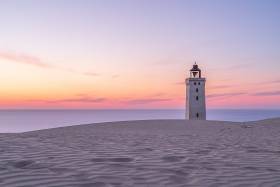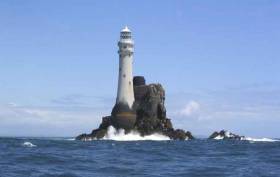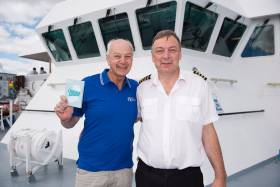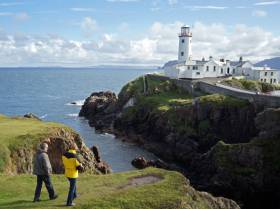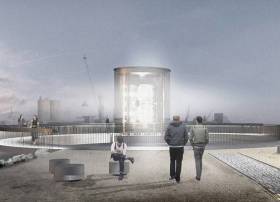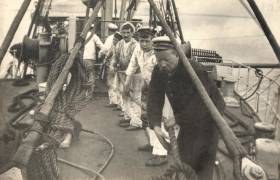Displaying items by tag: lighthouses
Strategic Rail Review Recommends Hourly Inter-City Trains & Reopening of Port Freight Connections
An hourly train service should be operating between major cities and at least one train every two hours between other urban centres, according to a new report that recommends the transformation of the current rail system including port rail freight.
At a launch (yesterday, 25 July), Minister for Transport Eamon Ryan will bring the draft report of the first All-Island Strategic Rail Review (AISRR). The review makes for 30 recommendations that will be brought to the Cabinet.
The AISRR wants to have faster speeds amd improved frequency in addition to new rail routes for people and those for freight. The latter is particularly aimed to be in place across the west and north regions of the country.
Recommendations in the report would take a timeframe beyond 25 years to achieve, however several of the proposals could be implemented beforehand by 2030.
Among the recommended proposals include reducing the level of trucks off the roads with the Limerick to Foynes Port railway reinstated for freight as Afloat previously reported and potentially for passengers returning on the Shannon estuary rail link.
In addition another rail-freight project is to start reopening the south Wexford railway line connecting Waterford and Rosslare Europort, operated by Irish Rail (Iarnród Éireann).
In addition there is a suggestion to develop a rail line around Dublin Port.
For more on the AISRR recommendations including Northern Ireland, RTE News reports as well to coverage of matters maritime, as the Minister also highlighted issues facing lighthouse authorities on both sides of the Irish Sea.
General Lighthouse Authorities
The Minister is seeking Cabinet approval for an international agreement between the General Lighthouse Authorities (GLA) in Ireland and Britain.
Responsibility for the navigation safety around the coasts of Ireland and the UK is overseen by the three lighthouse authorities as Afloat has featured notably of recent years given plans to replace ageing aids to navigation vessels with newbuilds.
The GLA's are the Commissioners of Irish Lights for Ireland and Northern Ireland, the Northern Lighthouse Board for Scotland and the Isle of Man, and Trinity House for England, Wales, the Channel Islands and Gibraltar.
All three GLA's have used joint procurement measures to benefit from the economies of scale and by having closer operational ties. This process was straightforward when all the three lighthouse authorities were under the same EU procurement regime.
However, given post-Brexit this has led to a new solution being required.
The Minister has been advised by the Attorney Gerneral that an international agreement be implemented so to enable the GLA's to achieve solutions.
Among them is the key contract to provide helicopter services needed to service lighthouses in offshore remote locations in particular on Ireland's western seaboard.
Great Lighthouses of Ireland Book to Be Published in November
The Great Lighthouses of Ireland is a collection of extraordinary stories of sophisticated engineering, fatal shipwrecks, heroic sea rescues and lives spent defying the elements.
Through more than 300 stunning images and historic details, this beautiful book brings to life the romance and history of our coastal guardians that evoke such fascination.
Published as an accompaniment to the TV series of the same name, producer and author David Hare’s beautiful gift book is a visual tour of some of our best-known lighthouses, including Ballycotton, Fastnet, Valentia, Loop Head and Fanad Head.
It chronicles the evolution of lighthouse design, the incredible challenges overcome during construction and maintenance, the daily lives of the brave and isolated keepers, and the inspiring tales of heroism and rescue at sea.
With stunning drone footage and stories of daring adventure, The Great Lighthouses of Ireland describes the incredible feats of engineering and invention it took to create the iconic beacons that stud our coastline.
Author David Hare founded Inproduction TV in 1990. The company specialises in factual series and documentaries and supplies RTE, PBS in America, BBC, Channel 4 and broadcasters around the world with programmes.
The Great Lighthouses of Ireland by David Hare will be published by Gill Books on Thursday, 3 November 2022, priced at €27.99.
The Great Lighthouses of Ireland, €27.99/£26.99, Hardback, 978 07171 9525 1
History of Lighthouse Optics Explored in RTE's Great Lighthouses of Ireland This Sunday
Great Lighthouses of Ireland (series two, programme three) continues this Sunday, May 22nd 2022 on RTÉ One TV at 6.30 pm
Lighthouse technology is constantly evolving, ensuring that lights are as bright as possible for the safety of the mariner at sea. This third episode explores the fascinating history of lighthouse optic engineering and ingenuity, from the basic oil burners and reflectors of the 1700s to the invention of the Fresnel lens which dramatically enhanced the power of the light; improvements to the light sources, and how lighthouses got their characteristic flashes.
A short distance from Cromwell Point lighthouse, Valentia Island, Co Kerry, is the landing place for the first transatlantic cable: the most advanced communications technology in the world in the mid 19th century.
 Mícheál Lyne, Kerry Historian
Mícheál Lyne, Kerry Historian
Spanning 2,500 miles from Newfoundland to Valentia, across an ocean which is 2 miles deep in places, the successful laying of the cable has been described as the equivalent of the moon landings for the people of that era.
After two attempts, the third proved to be successful and in 1866 the entire cable was carried and laid by one ship, ‘The Great Eastern’, whose first officer was Robert Halpin from Wicklow Town, Co. Wicklow. The Valentia cable station had a huge economic and social impact on the island, and the last telegraphic message was sent in 1966 as radio wave technology took over.
Ireland’s lighthouses also played a part in the development of radio wave and wireless technology. Radio wave pioneer Guglielmo Marconi was born in 1874 to an Irish mother and an Italian father. Marconi was able to achieve what had previously been regarded as impossible, and prove that electrical waves could cross the Atlantic wirelessly and without the need for cables. By 1904, radio signalling technology had been installed on the Fastnet lighthouse meaning the keepers could be contacted quickly from the shore, and could also send danger signals and messages about the light. A new chapter in technology began as radio waves were used to save lives at sea.
Perhaps the most challenging job of all within the lighthouse service was that of a lightshipman.
 David Higginbotham, a former Lightship man is interviewed in Programme Three of RTE's Great Lighthouses of Ireland
David Higginbotham, a former Lightship man is interviewed in Programme Three of RTE's Great Lighthouses of Ireland
Even tougher than living on a remote lighthouse station, lightships were anchored into place and truly at the mercy of the sea. For almost 250 years lightship men were stationed around the Irish coast, displaying incredible bravery, integrity and strength of mind. Former lightship men describe conditions on a lightship, including the psychological challenges, food shortages, overdue reliefs and the constant threat of being struck by another vessel.
The loss of the Puffin lightship near the Daunt Rock in 1896 illustrates just how dangerous it was to be a lightshipman. Despite being the height of technology, the Puffin was destroyed in a violent storm with the loss of all 8 crew who were never found. Using 19th-century diving technology, the wreck of the Puffin was found against all odds and brought to shore. Ireland’s lightships were gradually replaced by automatic buoys, and the last lightship ‘The Gannet’ was decommissioned in 2009 and removed from the Co. Down coast.
Great Lighthouses of Ireland is produced and directed by David Hare of InProductionTV for RTÉ in association with Irish Lights
Admiral Beaufort, Storm Ophelia and The Bull Rock Feature in Programme Two of Great Lighthouses of Ireland This Sunday
The hugely popular* Great Lighthouses of Ireland is back for a second series with more stories about the lighthouses around Ireland’s coast and the extraordinary men and women who lived and worked in them, including the lightship keepers whose working conditions were even tougher than those on the remotest of Ireland’s rock stations.
The series covers a wide range of topics designed to appeal, as the first series did, to all ages. Shipwrecks, the power of waves, the disastrous 1979 Fastnet Race, lighthouses in art, storms, engineers, lightships, Marconi, Admiral Beaufort, bird surveys, the Dingle lighthouse keeper who first spotted Fungie the dolphin, the importance of food and the tactics employed by lighthouse keepers to get on with the men they shared a very small space with, are just some of the topics explored.
 Admiral Beaufort
Admiral Beaufort
Cinematic photography, dramatic aerial footage and remarkable characters create another compelling and memorable series.
*When the first series was shown in September 2018 at 18:30 on Sunday evenings, it increased RTE’s share of the audience in all age groups and every socio-economic category.
Programme two on May 15th 2022 - RTÉ One, 6.30 pm
Ireland’s coastline is notoriously rugged and treacherous, and over 18,000 shipwrecks have been recorded in Irish waters. Many of these wrecks occurred during the 19th century when ships became larger and faster: the sinking of the Queen Victoria on the rocks below the Baily Lighthouse, Co. Dublin is an infamous example.
Admiral Francis Beaufort, originally from Navan, Co Meath, dedicated his life to making vital improvements to navigational charts mapping. As Chief Hydrographer to the Royal Navy, he created maritime maps and charts that were still in use until the 1970s.
Ireland’s marine territory is roughly ten times the area of the island of Ireland, making Ireland one of the largest territorial countries in Europe. This dramatic increase of territory was made official by the United Nations Convention on the Law of the Sea, and how it is illustrated in the ‘Real Map of Ireland’.
Over on the east coast, the seabed, largely comprising sand and mud, is constantly changing. This is very evident at the notorious Kish Bank off the coast of Dublin, a shallow and dangerous sandbank. Since 1810, a series of lightships, and eventually a lighthouse, have helped mariners passing Kish Bank (the lighthouse itself is an astounding feat of 20th century engineering).
Storms are one of the most lethal threats to mariners around the Irish coast. Admiral Beaufort devised the universally recognised method to describe wind strength, the Beaufort Wind Scale. Deadly Atlantic storms can erupt in a matter of hours.
In 2017 Storm Ophelia seriously damaged the lighthouse keepers’ cottages at Old Head Kinsale.
Although the lighthouse and cottages are perched 30 metres above sea level, waves smashed through windows destroying bedrooms, the sitting room and most of the downstairs, as we see in home videos made by Attendant Alan Boyer's wife Cathy Lennon. Despite being an experienced lighthouse keeper and attendant, Alan admits to being frightened as he and his family huddled at the top of the stairs.
 Lighthouse Attendant Alan Boyer
Lighthouse Attendant Alan Boyer
Since the 19th century, Irish Lights has owned and run its own ships. The latest in a historic line of Irish Lights vessels is the Granuaile which plays a vital role in deploying and recovering buoys, hydrographic surveys, seabed sampling and mapping, search and rescue operations and helicopter support. Past and present crew members offer insights into life onboard Irish Lights’ ships which have served anyone who has sailed around the Irish coast for the past 200 years.
 The Irish Lights Vessel Granuaile
The Irish Lights Vessel Granuaile
Great Lighthouses of Ireland is produced and directed by David Hare of InProductionTV for RTÉ in association with Irish Lights
Lighthouse On Rails: Denmark Moves Landmark Light From Eroding Coastline
A lighthouse in Denmark that was first lit in 1900 has been moved further inland on special rails to protect it from coastal erosion.
TheJournal.ie reports on the 23-metre-tall Rubjerg Knude, which was deactivated in 1968 yet remains a popular landmark in the far north of Denmark.
However, the area is subject to shifting sands and coastal erosion that saw the lighthouse museum and coffee shop abandoned in 2002, and even led to the dismantling of 750-year old church close by in 2008.
Originally 200 metres from the shore, the lighthouse was just six metres from the edge when works began last week to move it some 70 metres inland on a set of specially built rails to accommodate its heavy masonry.
It’s now hoped that the future of the lighthouse, described by Danish environment minister Lea Wermelin as “a national treasure”, has been assured until 2060.
TheJournal.ie has more on the story HERE.
New Fastnet Lighthouse Light to Go Live on Monday
The new light on Fastnet Rock Lighthouse is scheduled to go into operation on schedule on the evening of Monday 2nd July, the Commissioners of Irish Lights has confirmed.
The new rotating lantern will have the same character as the existing light and a range of 18 nautical miles. The lighthouse will continue to provide an essential safety service for mariners as well as being visible along the Cork shoreline from Mizen Head to Castletownshend.
The switch to the new light will facilitate commencement of essential structural works which are required to renew the attachment of the lantern room to the masonry structure of the tower. Work will continue on Fastnet until late August 2018 and final completion works will take place in summer 2019. On completion, the outward appearance of Fastnet will be unchanged.
Irish Lights Director of Operations, Captain Robert McCabe, said: “The present works at Fastnet are part of the continuing investment programme of maintenance, upkeep and modernisation of the aids to navigation services provided by Irish Lights to the mariner. The project being undertaken at Fastnet involves important structural works to secure the station for the future, and the installation of a new light on a replacement platform above the dome. The works will improve safety and the environmental footprint at the station while having no impact on the outward appearance of the lighthouse.”
The public consultation process undertaken with the project has led to increased consideration of the international importance of Fastnet as a unique example of lighthouse heritage and the potential for the site to achieve UNESCO World Heritage List status.
Irish Lights responded to this interest and commissioned an independent expert report which concludes that the present works on Fastnet do not negatively impact on its potential for world heritage status. The report also found that the consideration of Fastnet for UNESCO status would best be progressed jointly with other countries operating similar towers.
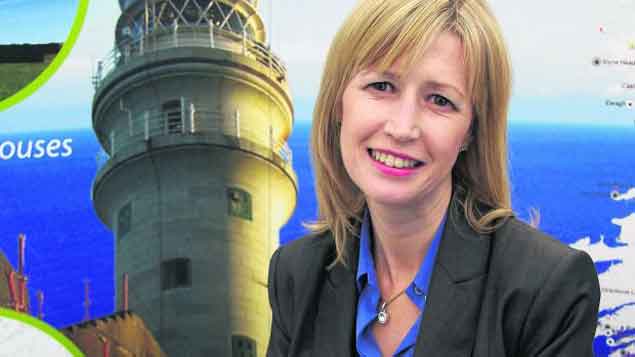 Irish Lights CEO, Yvonne Shields
Irish Lights CEO, Yvonne Shields
Irish Lights CEO, Yvonne Shields, said: “Our discussions with the local community and interested parties raised the question of Fastnet qualifying for UNESCO World Heritage Status. In response, we commissioned a report from an international expert to explore the potential for Fastnet to be considered a world heritage site and to get a better understanding of the context within which this might be considered.
“The consultant confirmed the criteria under which he felt the Fastnet might qualify for UNESCO status and confirmed that the work underway at the site will not impact negatively on this ambition. The report notes that the World Heritage Committee specifically recognises the importance of continual renewal of internationally important industrial world heritage sites in the context of their sustained use as viable working entities.
“Irish Lights will work with stakeholders and the community to determine the best way to advance the important heritage value of Fastnet as an international landmark.”
The Great Lighthouses of Ireland Partnership, the all-island tourism initiative developed by the Commissioners of Irish Lights, has announced Insomnia Chairman, Entrepreneur and TV and radio personality Bobby Kerr as the new Independent Chairperson to support the project’s development. A keen yachtsman with a passion for all things maritime, Bobby will chair the body which features twelve lighthouses in breath-taking coastal locations from Donegal to Cork and from Antrim to Wexford.
In his first act as Chairperson, Bobby attended Seafest 2017 national maritime festival in Galway where he met with GLI Partners, lighthouse operators, and representatives from the Commissioner of Irish Lights.
Bobby takes up the pro-bono role at an exciting time for Great Lighthouses of Ireland, with the Partnership having recently agreed a new marketing and development strategy up to 2020 with the aim of driving up visitor numbers and growing revenue. The GLI Partnership will benefit from Bobby’s business expertise and understanding of community projects to help in building the profile of the lighthouse properties.
With tourists offered the chance to both visit and stay in a lighthouse, the twelve GLI sites combined attracted some 135,000 visitors in 2016. There are over 19,000 bednights available across the various lighthouses; GLI Partnership is forecasting a 9% growth in visitor numbers and over 60% visitor occupancy in bednights in 2017. Both funding and resources have been committed to position the 12 lighthouses as must see, unique and high quality experiences for domestic and international visitors.
Welcoming Bobby Kerr’s appointment, Chief Executive of Irish Lights, Yvonne Shields commented: “Our maritime heritage is a great source of pride. Through Great Lighthouses of Ireland, Irish Lights has brought together a group of people who are deeply rooted in our coastal communities and hugely committed to our lighthouse heritage, and we are delighted that Bobby Kerr will be working with us to support this leading-edge project.”
“Given the success of this initiative to date, Bobby’s background and experience will be of huge value in guiding and informing the future work plans and objectives of the partnership and we look forward to developing exciting new collaborative initiatives with our lighthouse partners over the next phase of development of the project.”
Speaking as he accepted the invitation to act as Chairperson, Bobby Kerr said: “I’m incredibly excited to be given this unique opportunity to contribute to such a high-profile and imaginative tourism offering as the Great Lighthouses of Ireland.
I am committed to ensuring that this partnership adds value to the national tourism development agenda, partners and coastal communities in a manner that is sustainable and one that we are all proud to be associated with.”
Great Lighthouses of Ireland
Great Lighthouses of Ireland is an all-island tourism initiative, developed by the Commissioners of Irish Lights, the General Lighthouse Authority for the island of Ireland. Featuring twelve lighthouses in breath-taking coastal locations, Great Lighthouses of Ireland offers visitors from home and abroad the chance to visit or stay in a lighthouse, to find out about their history, to appreciate the spectacular natural world around them, to discover the technology at work in lighthouses today and to meet the people who are passionate about these unique places.
Great Lighthouses of Ireland partners include the Irish Landmark Trust, the Royal Society for Protection of Birds, Forbairt Fhanada Teoranta (Fanad Community Group), Clare County Council, Ballycotton Lighthouse Tours, Mid & East Antrim Borough Council, Hook Heritage Limited, Valentia Island Development Company and Clare Island Lighthouse. Great Lighthouses of Ireland is also supported by Tourism Ireland, Fáilte Ireland and Tourism Northern Ireland.
Full list of Great Lighthouses of Ireland:
St John’s Point, Co Donegal
Fanad Head, Co Donegal
Rathlin West Light Seabird Centre, Co Antrim
Black Head, Co Antrim
St John’s Point, Co Down
Wicklow Head, Co Wicklow
Hook, Co Wexford
Ballycotton, Co Cork
Galley Head, Co Cork
Valentia Island, Co Kerry
Loop Head, Co Clare
Clare Island, Co Mayo
#lighthousePics - The guardians of some of Ireland's most iconic lighthouses, the Commissioners of Irish Lights are looking for new and exciting images of Lighthouses located along our stunning coastline.
Whether you are a professional photographer or just a budding enthusiast who likes to take snaps on your compact camera or smartphone, Irish Lights want you to share your best pictures with them.
From time to time Irish Lights may use these pictures in their publications for both internal corporate and external public viewing and if they do you can rest assured that all credit for your picture will go to you. This is a great way to get your work seen and to share in our passion and commitment to serving the mariner.
If you would like to share your photos with Irish Lights email any image to the dedicated email address [email protected]
Please make sure you include your name and a note to state that the picture is an original and was taken by you, and that you give permission for its use if we so choose.
For more about Irish Lights in general visit their website here.
Green Light For Historic Lighthouse Optic On Belfast Waterfront
#MewIslandOptic - Plans to install a rare lens from one of Ireland’s tallest lighthouses on Belfast’s waterfront have been given the green light.
As previously reported on Afloat.ie, plans were announced last summer to house the optic from Mew Island Lighthouse in Belfast Lough in a much more accessible structure designed by architects Hall McKnight.
Now the News Letter reports that planning permission has been granted to install the 130-year-old, seven-metre-tall optic in the Titanic Quarter as the centrepiece of the new Titanic Walkway in the coming months.
“We are now one step closer to helping save and restore one of the largest optics of its kind ever constructed, an artefact of national and international significance,” said Titanic Foundation chief executive Kerrie Sweeney.
“This will certainly create a legacy Belfast landmark which will inspire our future generations.”
The News Letter has more on the story HERE.
Touring Exhibition: Safety at Sea through War and Upheaval: Irish Lights 1911-1923
#Exhibition - The Commissioners of Irish Lights and the Royal Irish Academy continues to tour an exhibition around our coastline that captures the history of Irish Lights.
Having first exhibited last year in Cobh as Afloat reported on the next venue will be Wexford at the town’s County Office HQ and is scheduled from 23 January-5 March. The location is at Carricklawn (close to Wexford General Hospital) on the (R769) road that leads west out of the town.
The history of the island of Ireland itself, its ever-changing coasts and shorelines, and the history of the people who lived along our island’s seaboard. Through the nineteenth century the number of Ireland’s lighthouses increased from fourteen to seventy-four, with eleven lightships placed around the east and south coasts.
The exhibition explores how Irish Lights, with its origins in the late-eighteenth century, and coming of age in the certainties of the nineteenth, faced the challenges of global and national uncertainty in the early twentieth century. Precisely, the exhibition details Irish Lights’ history between 1911 and 1923.
Also explored in the exhibition through these years are the incredible events, such as; the Easter Rising of 1916, the Anglo-Irish War of 1919–1921 and the Anglo-Irish Treaty.
What emerges is a never-before told story of devotion to duty, scientific, engineering and physical endeavour, world war, revolution and change.
It is also a deeply personal story of those who worked with and built up Irish Lights. Those who devoted their lives to protecting the coastline for the safety of all which remains to the present day and by keeping abreast of future technological developments.


























